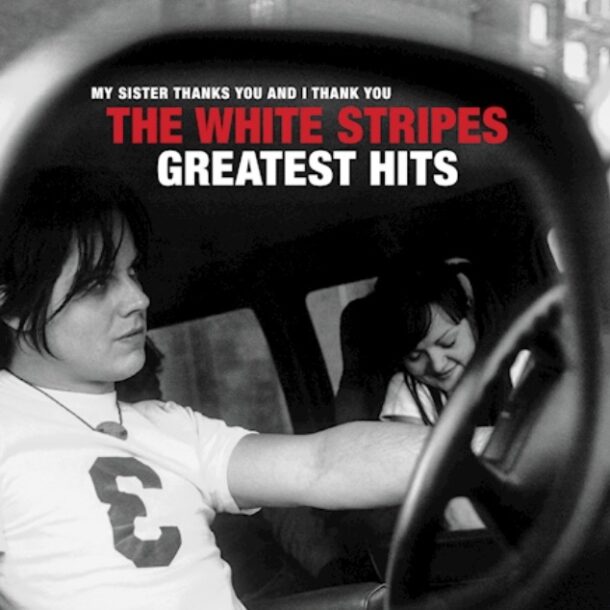
By AVA LIVERSIDGE
Much to the chagrin of hopeful rock fans hanging onto the dregs of hard bluesy-rock last seen in the early 2000s, 2020 will not be the year of a White Stripes revival.
However, it seems like rock gods have heard prayers everywhere and blessed fans with a new collection: My Sister Thanks You and I Thank You,TheWhite Stripes Greatest Hits, released on December 4th. While we won’t get a tour, new recordings, or a public appearance of the ever-elusive Meg White, Third Man Records, headed by the Stripes’ other half Jack White, has promoted the album with witty, heartfelt gimmicks and interactive experiences.
The White Stripes need not gift their devoted fans anything other than the record itself, but Jack White, often touted as a reluctant rock n’roll savior who has been compared to both Willy Wonka in antics and Edward Scissorhands in looks, has never been known to do the bare minimum. White is widely regarded as a creative genius, but his allure comes from the very rejection of that label. In fact, White is hesitant to even call himself a musician, often deeming such a label something only those who have surrendered their entire lives to their creations deserve, comparable to the sacrifice of priests.
Well the devotion with which White lives his music is abundantly clear on the beloved work he did during his ten years with the band that launched his career and changed the music industry forever. While there are countless contributions White has made to the industry, including working extensively to aid in the revival of vinyl records, preserving hundreds of Delta Blues records, and producing numerous albums, ensuring proper and fair representation to smaller recording artists, these projects all began with the Stripes. The Detroit duo made their full-length debut in 1999 with the self-titled album and didn’t stop until the release of their full-length live album Under Great White Northern Lights in 2010 , following their full-length extensive tour of each Canadian province – very White Stripes.
Over six full-length albums, countless singles, and trademark quirks, the White Stripes staked their claim as not only rock legends and revivalists, but also as trailblazers for their unique genre of garage rock with blues elements that have rarely been so explicit in rock. At the end of the day, and what Jack White would tell you, is that the White Stripes are a blues band hiding behind the catchiness and marketability of do-it-yourself garage rock.
Jack credits this success mainly to the gimmicks – the peppermint candies, the three colors, the brother and sister duo – which distracted from the fact that they were another white blues band from Detroit. With the White Stripes, more than Zeppelin and more than the Stones, the blues have never reached such obvious mainstream success.
The White Stripes, and specifically Jack White, maintained a strict and impressive dogma regarding their image and music, all circulating around the minimalism of the number three. The goal was simple: to create raw, virile blues music utilizing only the bare minimum of tools, a cheap, yet mighty Airline guitar and primitive drumming.
It is important to note than guitar-connoisseur, vocalist, pianist, producer, and songwriter extraordinaire Jack White would have been somewhere different without the primal and ever-simple drum playing of Meg White. Without that simplistic quality — a quality that kept the band grounded as Jack’s skill progressed and more opportunities were opened — the nature of the band would be convoluted. They confined themselves to simplicity so that an inventive creativity might blossom. The Stripes taught the valuable lesson that it is easy to shine when accessibility and resources are abundant, but only something truly sublime can happen when the only place to turn is to a place of meticulous creativity under non-conducive circumstances: three colors, cheap instruments, no setlists, two people.
If asked to name their greatest hits, every Stripes fan would say something different. In fact, they had a chance to when Third Man Records put together a competition via Spotify for fans to try and guess the record’s track list. The Stripes make songs that speak to people, that permeate their fans’ thoughts and emotions, not just tracks that are well-produced or that have catchy melodies to chant at stadium arenas.
This can make choosing a tracklist difficult, but Jack White and Third Man Records were able to curate a list that spanned across their entire discography and included the group’s diverse ability from high-energy, high-intensity screeching tracks like “I Think I Smell A Rat” to the softer balladry of “Apple Blossom,” a track that, in promotion of the album,was honored in a haunting animated music video.
While the selection lacks many of their acoustic variety, those have previously been revitalized in Jack White’s solo project Jack White Acoustic Recordings 1998 – 2016 released in 2016. The curation uniquely redefines “greatest hits” as the Stripes, while they definitely did have major hits that are featured- “Seven Nation Army,” “Hardest Button to Button,” etc., make sure to highlight tracks that characterized the group throughout their career. Tracks like “Let’s Shake Hands,” which appeared on their first-ever released 7-inch, was specially featured with a second animated video and evidently made an enormous impact on how the band will be remembered as garage rock legends. Holistically, the compilation does exactly what it set out to do, which is to pay homage to the duo that defined a decade.
White aptly subtitled the compilation My Sister Thanks You and I Thank You, and while Stripes fans worldwide remain dubious about the familial claims that continue to be made, we thank you too.


